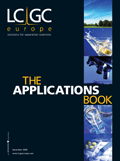Determination of Soft Drink Ingredients
The Application Notebook
Soft drink formulas often include preservatives, artificial sweeteners, flavours or caffeine in their list of ingredients. Using the Acclaim OA column, as many as eight common additives may be determined in a single run. Many of these additives are hydrophilic organic acids for which this column was designed. Notably, benzoate and sorbate, which do not resolve on C18 columns at low pH, are fully separated.
Soft drink formulas often include preservatives, artificial sweeteners, flavours or caffeine in their list of ingredients. Using the Acclaim OA column, as many as eight common additives may be determined in a single run. Many of these additives are hydrophilic organic acids for which this column was designed. Notably, benzoate and sorbate, which do not resolve on C18 columns at low pH, are fully separated.
Materials and Methods
All equipment was supplied by Dionex Corp., Sunnyvale, California, USA, including the HPLC system and Acclaim OA 4 × 150 mm column.
Mobile phase A: 14.2 g/L Na2SO4 (Sigma) and 0.550 mL/L methanesulphonic acid (Fluka); nominal pH is 2.65.
Mobile phase B: Methanol (Fisher).

The flow-rate was 0.80 mL/min, and the column temperature was set to 30 °C. The detector was monitored at 210 nm, with alternate wavelengths of 230 and 262 nm.
Samples were prepared by filtration through a 0.45 µm nylon membrane filter, and diluted 5× with mobile phase A. 10 µL was injected.
The standard was prepared in mobile phase A from individual stock solutions of 1000 µg/mL.
Discussion and Conclusion
The range of hydrophobicities for these additives precludes isocratic methods. At 210 nm, a plain gradient ramp would result in a sloping baseline that makes quantification difficult, therefore, a three-step solvent program was chosen. All the peaks elute in flat portions of the baseline.

Figure 1
Ordinary C18 reversed-phase columns are not suitable for this application for two reasons. First, the separation of erythorbic and citric acids requires a purely aqueous buffer, and conventional C18 columns tend to suffer from dewetting under these conditions. Second, sorbate and benzoate require the different selectivity of a polar-embedded stationary phase to separate them at the low pH needed for the other acids. The Acclaim OA is an aqueous-compatible, polar-embedded column that is designed for the resolution of hydrophilic organic acids, so it is well suited to this application.
Other flavour ingredients and colourings do not interfere. This method does not fully resolve erythorbic acid from ascorbic acid, nor aspartame from saccharin. Fortunately, these combinations are not usually seen in commercial soft drink formulas. Therefore, one may make an alternative standard mixture to accommodate a particular formula, without altering the conditions of the method.

Dionex Corporation
1228 Titan Way, Sunnyvale, California 94088, USA
tel. +1 408 737 0700 fax +1 408 730 9403
Website: www.dionex.com

Analytical Challenges in Measuring Migration from Food Contact Materials
November 2nd 2015Food contact materials contain low molecular weight additives and processing aids which can migrate into foods leading to trace levels of contamination. Food safety is ensured through regulations, comprising compositional controls and migration limits, which present a significant analytical challenge to the food industry to ensure compliance and demonstrate due diligence. Of the various analytical approaches, LC-MS/MS has proved to be an essential tool in monitoring migration of target compounds into foods, and more sophisticated approaches such as LC-high resolution MS (Orbitrap) are being increasingly used for untargeted analysis to monitor non-intentionally added substances. This podcast will provide an overview to this area, illustrated with various applications showing current approaches being employed.
Detecting Hyper-Fast Chromatographic Peaks Using Ion Mobility Spectrometry
May 6th 2025Ion mobility spectrometers can detect trace compounds quickly, though they can face various issues with detecting certain peaks. University of Hannover scientists created a new system for resolving hyper-fast gas chromatography (GC) peaks.
Altering Capillary Gas Chromatography Systems Using Silicon Pneumatic Microvalves
May 5th 2025Many multi-column gas chromatography systems use two-position multi-port switching valves, which can suffer from delays in valve switching. Shimadzu researchers aimed to create a new sampling and switching module for these systems.
Characterizing Polyamides Using Reversed-Phase Liquid Chromatography
May 5th 2025Polyamides can be difficult to characterize, despite their use in various aspects of everyday life. Vrije Universiteit Amsterdam researchers hoped to address this using a reversed-phase liquid chromatography (RPLC)-based approach.

.png&w=3840&q=75)

.png&w=3840&q=75)



.png&w=3840&q=75)



.png&w=3840&q=75)









